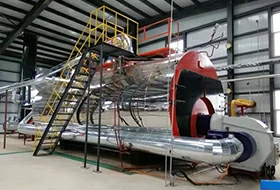
Nov . 01, 2024 02:52 Back to list
Understanding the Process of Steam Generation in Boiler Systems
How Steam is Produced by a Boiler
A boiler is an essential component in many industries, serving as a crucial device for generating steam. This steam plays a vital role in various applications, from heating and power generation to food processing and chemical manufacturing. Understanding how steam is produced by a boiler involves exploring the fundamental principles of thermodynamics, heat transfer, and the specific components that make up a boiler system.
How Steam is Produced by a Boiler
Once the fuel is ignited, it generates heat, which is transferred to the water inside the boiler. This heat transfer occurs in various ways, depending on the design of the boiler. In a fire-tube boiler, hot gases produced from the combustion process flow through tubes surrounded by water. The heat from these gases is conducted through the walls of the tubes and into the water, causing the temperature to rise. In contrast, in a water-tube boiler, water circulates through tubes that are heated by a surrounding fire chamber. This design allows for higher pressures and steam generation rates.
how steam is produced by a boiler

As the water temperature increases, it eventually reaches its boiling point. At this juncture, the water begins to convert into steam. It's important to note that steam generation requires a significant amount of energy, called enthalpy, to overcome the latent heat of vaporization — the energy needed to transform liquid water into steam without changing its temperature.
For a boiler to operate efficiently, it must maintain specific pressure and temperature conditions. The steam produced can be classified into two categories saturated steam and superheated steam. Saturated steam is formed when water boils at a given pressure, while superheated steam is produced when this steam is further heated beyond its boiling point at a constant pressure. Superheated steam is often used in power generation because it can drive turbines more efficiently.
Safety is a paramount concern in boiler operation. Boilers are equipped with various safety devices to monitor pressure and temperature. Safety valves automatically release steam when pressure exceeds safe limits, preventing potential explosions. Additionally, modern boilers now incorporate advanced control systems to optimize performance and efficiency, reducing fuel consumption and minimizing environmental impact.
In summary, the production of steam by a boiler involves heating water with a fuel source until it transitions into steam under controlled conditions. This process is fundamental in numerous applications across various industries. Understanding the mechanics of steam generation is crucial not only for efficient boiler operation but also for ensuring safety and environmental stewardship in industrial practices. As technology advances, the design and operation of boilers continue to evolve, emphasizing energy efficiency and sustainability in steam production.
-
High-Efficiency Commercial Oil Fired Steam Boiler for Industry
NewsJul.30,2025
-
High-Efficiency Biomass Fired Thermal Oil Boiler Solutions
NewsJul.30,2025
-
High Efficiency Gas Fired Thermal Oil Boiler for Industrial Heating
NewsJul.29,2025
-
High-Efficiency Gas Fired Hot Water Boiler for Sale – Reliable & Affordable
NewsJul.29,2025
-
High Efficiency Biomass Fired Hot Water Boiler for Industrial and Commercial Use
NewsJul.29,2025
-
High-Efficiency Biomass Fired Hot Water Boiler for Industrial Use
NewsJul.28,2025
Related PRODUCTS






















